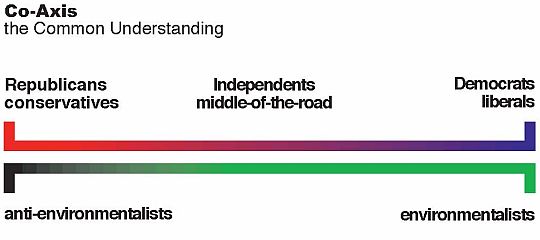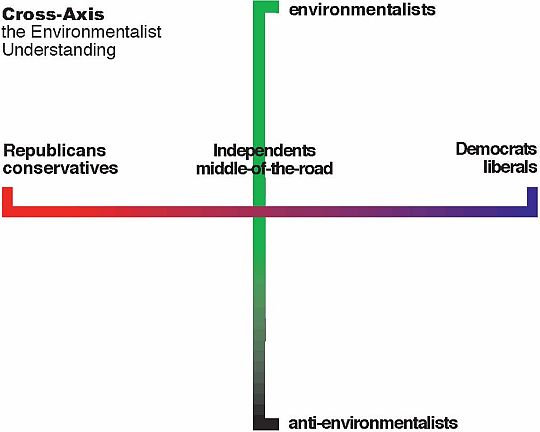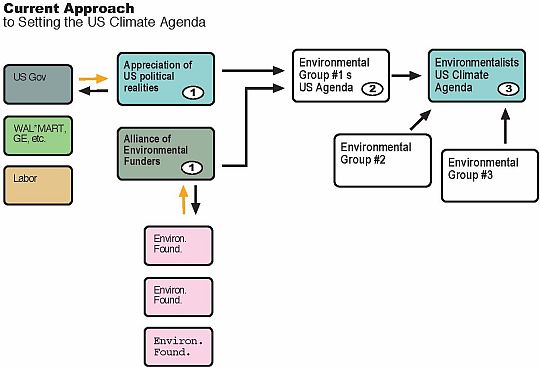There are several fundamental areas of disagreement that underlay the ostensible topics of debate here on Grist. I have pulled together three planning and training devices used by organizers and campaigners in the PIRG tradition, as well as Green Corps, that are helpful in surfacing and naming such disagreements — a common language for dispute, if you will.
Continuum of environmental action

A strength of environmentalism had been the flowering of its forms and politics. Our power has declined in direct proportion as our diversity has narrowed to an orthodox cannon of acceptable forms of environmental advocacy. At the height of our power, US environmentalism boasted vibrant organizational forms across a spectrum of strategy, tone, ideals and, probably most important, insider/outsider roles, particularly protest.
It is inappropriate to stuff that diversity into the straightjacket of one scale, but I’ve done so anyway because it underlines the overall point. (I don’t want to be flooded with complaints the this or that box is too small or the wrong color. If anyone feels strongly about it, to paraphrase Tom Leher, I am prepared not only to withdraw the chart but to swear under oath that I never created it to begin with.) In 1982 U.S. environmentalists had powerful organizations across the breadth of approach. Today, we are highly concentrated in a handful of specialized areas. But rather than acknowledging that we are weakened by this trend, we seem to be driving even further in the direction of splintering what is already an extremely fragile institution.
The value of drawing the continuum is that it encourages us to look at our efforts on an institutional scale, rather than a myopic organizational view.
Cross axis vs. co-axis
Thanks to Robert C. Paehlke, a professor of political science and environmental resource studies at Trent University in Ontario, there is a simple, graphic device to distinguish two ways of thinking about the relationship between environmentalism and traditional politics:

Most people conceive of environmentalism as a continuum, from environmentalist to anti-environmentalist, that runs more or less in the same direction as the dominant political paradigm of conservative to liberal. This perspective may be shown as parallel "co-axes," as in the chart above. (Some go further and reduce environmentalism to merely a point on the liberal end, but that is clearly erroneous as there are conservative environmentalists certainly exist in some numbers.)
The problem with this representation is that environmentalism attracts supporters within subgroups of traditional ideologues that cannot be charted on a straight line. There is a robust pocket of environmentalism in the otherwise very conservative group pollsters often label as “traditional conservatives,” far stronger and more numerous than Independents, who otherwise cleave to moderate positions, and a well entrenched beachhead of anti-environmentalism in blue collar, union, moderate-to-liberal households.
Paehlke suggests that a more accurate representation places the environmental continuum across the axis of traditional politics, as in the following chart. This cross-axis positioning is intuitively sensible, allowing any group and even individuals, to be plotted as a product of their stances on traditional and environmental scales.

Paehlke’s model is useful in a strategic context, because it helps sort out environmentalists from leftists. Environmentalists embrace the cross-axis, because it neatly illustrates that environmental values hold great appeal to people from all reaches of traditional politics, and is a nifty device for identifying often-overlooked opposition (when it is reflexively assumed that liberalism/progressivism automatically equates with environmentalism). Progressives, on the other hand, resist the cross-axis concept (often quite heatedly!) because they see environmentalism as just one more liberal cause and reject the notion that conservatives can be environmentalists.
The chain of logic
The very essence of environmentalism is the apprehension of the inter-connectedness of things in ways that are not easy to see quickly or closely. Environmentalists should start from the big picture and work out what to do, going from macro to micro views.
In fact, however, we do precisely the opposite. The US climate agenda evolves from micro-planning by individual organization, as shown in the following flow chart. What passes for institutional strategy is really the product of aggressive bumper car play by mini-coalitions.

How should planning be done? Climate scientists start with the macro-view and a timeframe measured in decades or centuries, rather than months and years. This central perspective meshes comfortably with a strategic planning device usually referred to as “walking backwards from the problem,” as shown in the following flow chart, which I think is fairly self-explanatory. [Note that a critical missing element is a US Council empowered to set joint strategy.]



